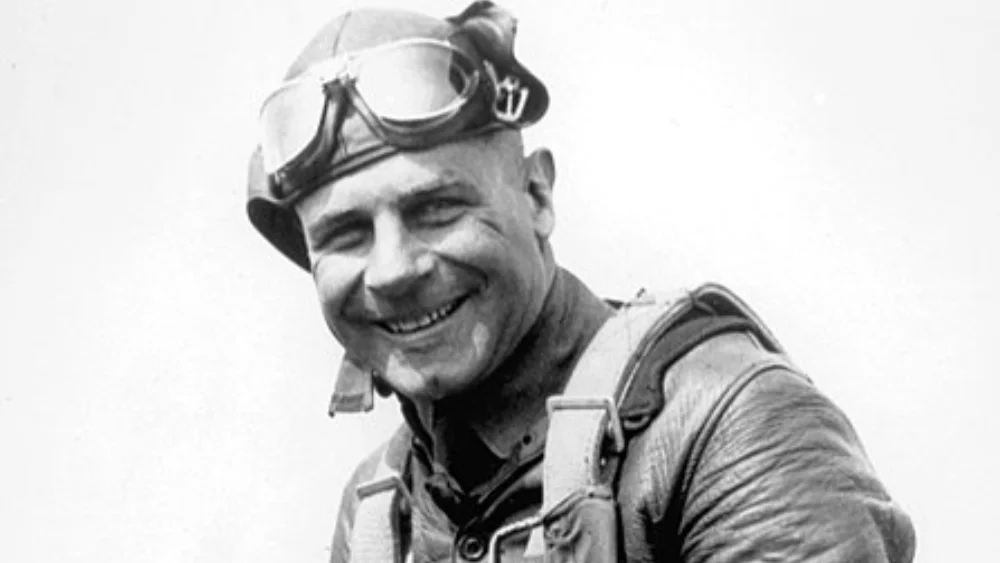Jimmy Doolittle, an American aviation pioneer and military leader, made a lasting impact on the history of flight through his achievements as a race pilot, innovative engineer, and bold military commander. Born on December 14, 1896, in Alameda, California, Doolittle’s journey through aviation began with a passion for speed and exploration.
Early Life and Aviation Aspirations
Jimmy Doolittle’s early life was marked by a profound fascination with machinery and technology, traits that would shape his remarkable journey in aviation. Even in his youth, he exhibited a natural curiosity and an innate understanding of how things worked, traits that would serve as the foundation for his later accomplishments. Doolittle’s passion for aviation was ignited by the pioneering achievements of the Wright Brothers, whose daring flights captured his imagination and sparked a lifelong aspiration to conquer the skies.
As a young boy inspired by the Wright Brothers’ groundbreaking feats, Doolittle’s journey from early life to becoming a legendary aviator would prove to be a testament to his relentless pursuit of excellence in the realm of flight. His lasting legacy as an aviation pioneer and war hero would not only shape the history of flight but also inspire countless individuals to reach for the skies and embrace the limitless possibilities of human innovation and exploration.
Jimmy Doolittle: World War I and Early Military Career
Jimmy Doolittle’s entry into military service during World War I marked the beginning of his illustrious journey in the world of aviation. Enlisting during a time of global conflict, Doolittle seized the opportunity to develop his burgeoning aviation skills. His determination to contribute to the war effort led him to the cockpit, where he embarked on a path that would define his career. Doolittle’s journey as a young aviator took flight as he learned to operate aircraft, honed his flying proficiency, and eventually assumed the role of a flight instructor, imparting his knowledge to the next generation of pilots.
World War I was a crucible for Doolittle, shaping him into a skilled aviator and instructor. It provided the early training ground for his aviation career, setting the stage for the extraordinary achievements and groundbreaking feats that would follow in the decades to come. Doolittle’s dedication to aviation during this formative period would not only serve his country during times of war but also pave the way for his enduring legacy as one of the most accomplished and respected figures in the history of aviation.
Air Racing: Setting Records and Pushing Limits
In the post-World War I era, Jimmy Doolittle emerged as a trailblazer in the world of aviation by channeling his skills and passion into air racing. This thrilling and competitive arena provided him with the perfect platform to push the boundaries of flight and showcase the incredible potential of aircraft technology. Doolittle’s racing exploits were not limited to the track; he consistently aimed higher and faster, setting multiple speed and distance records that captured the imagination of the aviation world. His achievements weren’t just about winning races; they were about pushing the limits of what was thought possible in the skies.
His foray into air racing not only solidified his reputation as a daring and accomplished aviator but also contributed to the advancement of aviation technology. By constantly striving for excellence and reaching new milestones, he played a pivotal role in the ongoing evolution of aircraft design and performance, leaving an enduring legacy of innovation and daring that continues to inspire aviators and enthusiasts to this day.
Jimmy Doolittle: The Gee Bee Racer
Doolittle’s collaboration with the Granville Brothers Aircraft Company marked a significant chapter in the history of aviation. Together, they embarked on a pioneering venture that would result in the creation of the iconic Gee Bee R-1 racer. This aircraft, renowned for its extraordinary speed and agility, pushed the boundaries of what was achievable in the world of aviation. Doolittle’s expertise and the Granville Brothers’ innovative designs came together to produce a remarkable machine that captured the imagination of aviators and enthusiasts alike.
The Gee Bee R-1 racer not only represented a triumph of engineering but also epitomized the spirit of adventure and daring that characterized Doolittle’s career. It became a symbol of excellence in aviation, and Doolittle’s association with this legendary aircraft solidified his status as a pioneering figure in the annals of flight history. The legacy of the Gee Bee R-1 and its contributions to the world of aviation innovation endures as a testament to Doolittle’s unwavering commitment to pushing the boundaries of what was possible in the skies.
The Bendix Trophy Race
The Bendix Trophy was a prestigious airplane race in the United States that started back in 1931 during the National Air Races. Its main goal was to encourage engineers to design faster, more reliable, and sturdier aircraft. The race route stretched from Burbank, California, all the way to Cleveland, Ohio. Jimmy Doolittle made history by winning the first race, flying a Laird Super Solution at an average speed of 223 mph over a distance of 2,043 miles. The Bendix Trophy attracted influential aviators like Amelia Earhart, Louise Thaden, and Jacqueline Cochran. The last Bendix Trophy Race took place in 1962.
Doolittle’s achievement in the Bendix Trophy Race wasn’t just about a single victory; it was a symbol of his relentless pursuit of excellence and his unyielding dedication to pushing the limits of aviation. His success not only inspired fellow pilots but also captivated a global audience, leaving a lasting impact on the history of air racing and solidifying his legacy as a true pioneer in the world of flight.
Jimmy Doolittle: Instrumental in Aviation Technology
Beyond his remarkable feats as a pilot, Jimmy Doolittle made enduring contributions to aviation technology that transformed the safety and precision of air travel. Doolittle’s pioneering spirit led him to the forefront of instrument flying systems and blind flight technology. His groundbreaking work in these fields revolutionized the way pilots navigated through adverse weather conditions and low visibility, significantly enhancing the safety of aviation operations.
Doolittle’s innovations in instrument flying not only improved the reliability and accuracy of aircraft navigation but also paved the way for the development of modern flight instrumentation. His dedication to advancing aviation technology underscores his enduring impact on the aviation industry, as his contributions continue to shape the way aircraft are designed and operated, ensuring that air travel remains safe and reliable for generations to come.
World War II: The Doolittle Raid
Jimmy Doolittle’s leadership during World War II stands as a testament to his unwavering dedication to the cause of freedom and his fearless pursuit of victory. His most iconic moment came in April 1942 when he led the daring Doolittle Raid on Tokyo. As the commander of this audacious mission, Doolittle and his brave crew members embarked on a perilous journey to strike back against the heart of the Japanese Empire. This remarkable act of courage and ingenuity not only dealt a psychological blow to the enemy but also demonstrated America’s resolve and capability to strike back, boosting American morale at a critical juncture in the war.
The Doolittle Raid remains a defining moment in World War II history and a testament to the extraordinary leadership of Jimmy Doolittle. His ability to inspire and lead under daunting circumstances, combined with his audacity and determination, made him a symbol of American heroism during the war. The legacy of the Doolittle Raid endures as a powerful reminder of the indomitable spirit and unwavering commitment of those who fought for freedom during one of the most pivotal periods in history.
Jimmy Doolittle: Post-War Contributions
In the post-war era, Jimmy continued to make substantial and enduring contributions to the field. As a military leader, Doolittle played a pivotal role in shaping the direction of aviation technology and strategy. His experiences and insights from the war informed crucial decisions in the U.S. Air Force, guiding its development as a potent and modern military force.
Furthermore, Doolittle’s influence extended beyond his military career as he transitioned into a prominent role as a civilian consultant and advocate for aviation progress. His expertise and vision helped shape commercial aviation, contributing to the safety and efficiency of air travel. His enduring legacy as a leader in both military and civilian aviation underscores his profound and lasting impact on the field, solidifying his reputation as one of the most influential figures in the history of flight.

Legacy and Awards
Jimmy’s legacy in the world of aviation is nothing short of legendary, and it is punctuated by a litany of prestigious awards and honors that recognize his extraordinary contributions. Among the most distinguished of these accolades is the Medal of Honor, the highest military decoration bestowed upon an individual for acts of valor above and beyond the call of duty. Doolittle’s courage and leadership during the daring Doolittle Raid on Tokyo in World War II earned him this prestigious honor, a testament to his unwavering dedication to the principles of duty and honor.
This recognition underscores his enduring impact on aviation and his vital role in shaping the course of history through his pioneering spirit and unwavering commitment to excellence. These awards, among others, serve as lasting tributes to Doolittle’s remarkable legacy, inspiring future generations to reach for the skies and continue his legacy of innovation, courage, and leadership in aviation.










